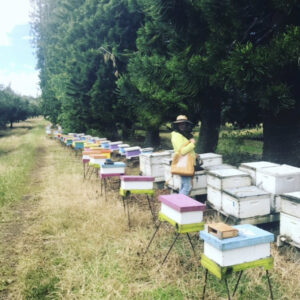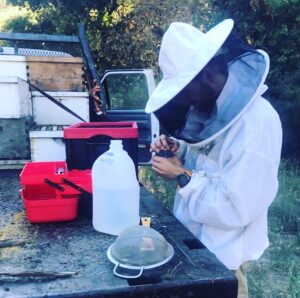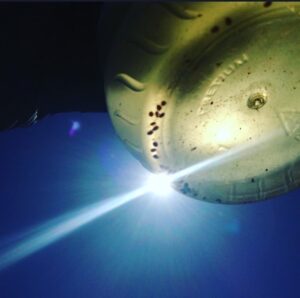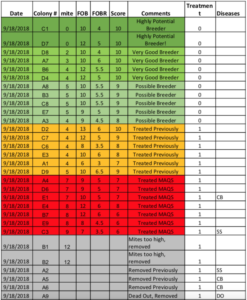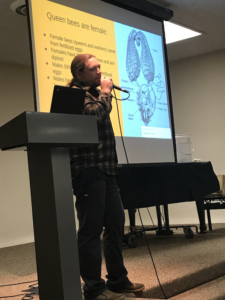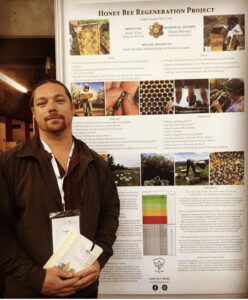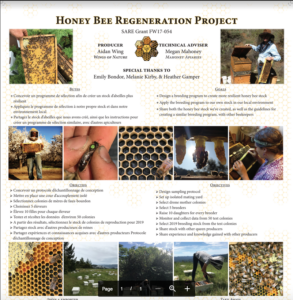Final report for FW17-054
Project Information
Cooperators
- (Researcher)
- (Researcher)
- (Researcher)
Research
We received the good news that we had received funding for SARE FW17-054 the Honeybee Regeneration Project in late spring 2017. Our initial plan to begin producing queens immediatly was delayed because we found that the stock from select bee breeders we planned to use in our trail was unavailable at that time. Though it seemed like a set back at first, in truth it gave us extra time to plan and implement our experiments by the following spring.
Our first question in beginning a breeding program was "where?". Because queen bees open mate in the air, in order to have some control over your breeding population you need to have some isolation. We looked farther in the hills to find such a place. We located a meadow amongst the redwood and oak forests of the western slope of the Santa Cruz Mountains. The area it was located in was several large privately owned parcels surrounded by preserve, ranch and timber land.
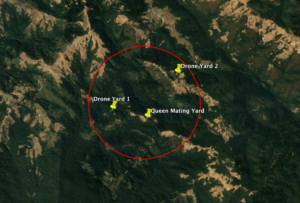
Two mile radius around queen mating yard
Next we needed to find locations to put the selected colonies that would supply the drones for out experiment. It is importune to have separate yards to raise drone colonies in. The drones leave their colonies to find DCA (drone congregation areas) away from their hives as a way to suppress inbreeding. We secured two yards each about a mile away.
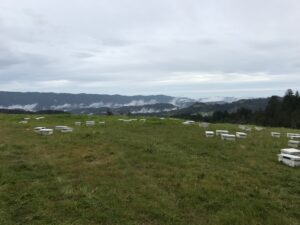
Queen mating yard
There were very few beehives in the area. We were happy to include any of the wild bees who had lived unaided in that wild environment into our breeding program via their drones. We made contact with the few local beekeepers and they enthusiastically were willing to participate in our program by introducing select queens to their own hives.
Having the extra time for the grant gave us the ability to really focus on selecting the drone-mothers for the project. Out of our 200 hives we selected these bees based on mite counts, honey production, gentleness and overall observations. We were able to select our 30 most favorable hives and move them to the drone yards before the spring of 2018.
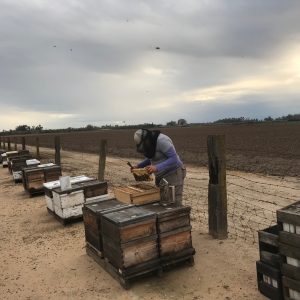
Selecting drone mother colonies
Over the summer of 2017 we were able to attain the breeding stock that we would utilize in our project the following queen season. We chose breeders from different parts of country who were selecting for similar traits that we desired. These queens were introduced to colonies and overwintered until the following queen rearing season.
During the winter we attained the equipment that would be used in the trial. We color coded the colonies which contained the breeder queens, then we took 50 boxes and color coded the handles to match with the breeder queens who would be the mothers of the queens in the trial. We attained other items that would be utilized in testing the bees such as a microscope and scale.
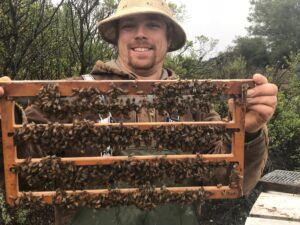
Young cells of the trial queens
In March of 2018 we grafted 10 daughters off of each breeder queen for a total of 50 queens. The queens were put in the isolated mating yard we had made the summer before the trial and they open mated with the drones who's genetics we had selected. After the queens were successfully mated they were placed in full size colonies in two separate testing yards. Two weeks after installation the colonies were equalized to give them an equal start to the trail, after that their populations were not manipulated. In May we began monitoring for mites, weighing the hives, making visual inspections and collecting the data. We repeated this process in the fall of that year and in early spring 2019.
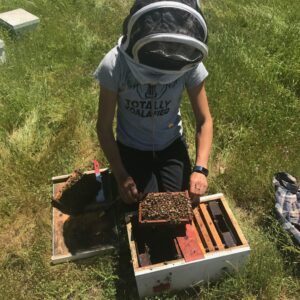
Marking queens
In January 2019 Aidan Wing (producer) traveled to meet Megan Mahoney (technical adviser) on the island of Hawaii. There he was able to learn first hand about the breeding work she was involved, spend time in her breeding apiaries and bee laboratory, and discuss the future direction of the grant process.
Breeding apiary on island of Hawaii
In the spring of 2019 we selected 5 breeder queens from the 50 initial colonies we had selected from. Of the 50 queens that had been tracked and data collected on we chose the 10% that stood far above the rest in genetic superiority. From the 5 queens that were selected as breeders we produced both daughter queens and nucleus colonies that were distributed through the local bee community. We continued to track the progress of the 5 breeder queens over the 2019 breeding season, and received feed back on the daughter queens we had distributed to other producers.
Sampling for mites
Mite sample
Initially we had proposed a large amount of breeding selection criteria as well as sampling on a monthly basis to accomplish our project. Very early in the trial we came to the realization that we were greatly over-extending ourselves, and that to accomplish sufficient results, as well as make the breeding protocol available to other breeders we needed to greatly simplify the sampling, data collecting and selections methods. Here are some of the lessons we learned about creating breeding protocol through the grant:
Use your time wisely! You don’t need too much
information, just pertinent information.
By refining the qualities you select for, data collection and hive analysis can
be simplified. Originally the plan was to evaluate more colony characteristics
at more frequent intervals. We found that less information was not only
more practical, but also sufficient to base breeding protocols on.
Trust your Instincts! Frontwards versus backwards selection
Originally the thought was to select for mite-resistance as the primary trait,
and then look for qualities of gentleness and productivity in those hives
as a secondary set of measures.. We found that the hives in our apiaries
that were gentle and productive were easier to identify. Both visually and
with a “gut feeling.” By monitoring hives that met the protocol for the most
desirable attributes we were able to reduce the number of hives sampled with
more time consuming procedures. We found that often the best colonies
in the beginning remained the best colonies by the end of the trial!
Have reasonable expectations! Shrinking selection pool
At first we were planning on collecting data from 50 hives throughout the year.
The time it took to sample all 50 hives was greatly reduced with each sampling
session as hives were removed from the breeding program for not meeting
sufficient standards. By the end of the trial we were collecting data from less
than 20% of the original test hives. With that in mind, it would be easier to start
with a much larger selection pool and sample more hives from more apiaries.
Be Realistic! Time of year
As professional beekeepers we are constantly busy keeping our hives healthy and
productive. Initially we tried to start the sampling process in our busiest season.
We found it near impossible to add any extracurricular activities to our already
busy schedule. We found using the less busy times of year for sampling and hive
analysis gave us all the information we needed to base our breeding decisions on.
These take aways from the grant have been incredibly relevant to the work we continue to due in our breeding program, and in giving other producers a very attainable toolset with which to create their own breeding programs. The methodology we created to sample, collect data and selectively breed are far more attainable to commercial beekeepers than many of the breeding programs implemented by universities and research institutes. At the same time the methodology provides more than sufficient information to make informed and impactive breeding decisions that go far beyond the process engaged by most queen producers.
Data collection sheet
Research Outcomes
Education and Outreach
Participation Summary:
Our first outreach was a queen rearing class we taught at our home farm in March 2018. We had 8 participants. We taught about our queen rearing method as well as breeding strategies. At the end of the workshop we handed out a survey to the participants.
In May 2018 we gave a talk at the Santa Cruz Beekeepers Guild about our project and research. There were 30 producers in attendance and they were also given a survey to see if they would incorporate any of the strategies we discussed in their own operations.
In March of 2019 we presented a slide show at the San Mateo Beekeepers Guild's meeting. There were 100 producers in attendance.
Aidan Wing Speaking at San Mateo Beekeepers Guild
In March 2019 we taught a second queen rearing workshop which was attended by 6 participants.
In June 2019 we hosted a field day at our home farm which was attended by 18 participants. We served food, gave farm tours and gave a talk about the breeding work we were doing.
In July 2019 we gave a presentation at the Western Apiculture Society conference in Ashland Oregon. It was attended by 120 people.
In September 2019 we did a poster presentation at Apimondia, a international bee conference in Montreal Canada. The conference was attended by over 10,000 beekeepers from all across the globe.
Poster presentation at Apimonida, Montreal
In December 2019 we did a speaking presentation at The Emerald Cup in Santa Rosa California about the breeding program we had designed with the grant.
At the beginning of the project we set up an Instagram page, a Facebook page and a website to make the information and process of the project available to producers world wide. Since then we have over 1500 followers to our various social media.
We hired Drala Studios to come film during various parts of the project. We still have those files and intend to edit and make them available in the future.
We have an invitation to write and submit an article about the project to Bee Culture, a nationally claimed beekeeping journal. We plan to write and submit this article over the summer 2020.
Portion of poster in both English and French
Education and Outreach Outcomes
In following through with the process of our original proposal, we learned that bee breeding is a perpetual, challenging and very time consuming process. It became evident very early that our original list of objectives for a honey bee breeding program was both excessive and unnecessary. By trimming down the list of breeding criteria we were collecting data for we ascertained that we were able to make conscientious and effective stock evaluation and selection decisions based on a much simpler set of protocols. Having the ability to design a breeding program, take samples, collect data and analyze that data in order to make stock selection decisions while at the same time running a functional beekeeping operation was key to the success of this grant, as well as future ones. By simplifying the breeding protocol we were able both to improve our stock, as well as not take away resources from our existing business.
We also found that in some ways we over-extended ourselves in our public outreach ambitions, However our outreach accomplishments were more than sufficient to reach a large number of other producers both locally, nationally and globally. We hosted two queen rearing workshops, had a field day, and presented at local beekeeping groups. We were able to create a website, a facebook page and an instagram account and attract well over a thousand followers who were curious to learn about the breeding program we created. I was able to travel Oregon to speak about the project at the Western Apiculture Society and to Montreal to speak at the internationally acclaimed Apimondia.
The American beekeeping industry is in great need of more bee breeding programs. Our struggle with varroa mite causes immense amounts of economic, environmental and social problems for both beekeepers, farmers and consumers. Both research and education will continue to be of great importance and in high demand for our industry to truly move towards lasting sustainability.
Section process
Breeding protocol
Sampling methodolgy
Data collection
Queen rearing process
